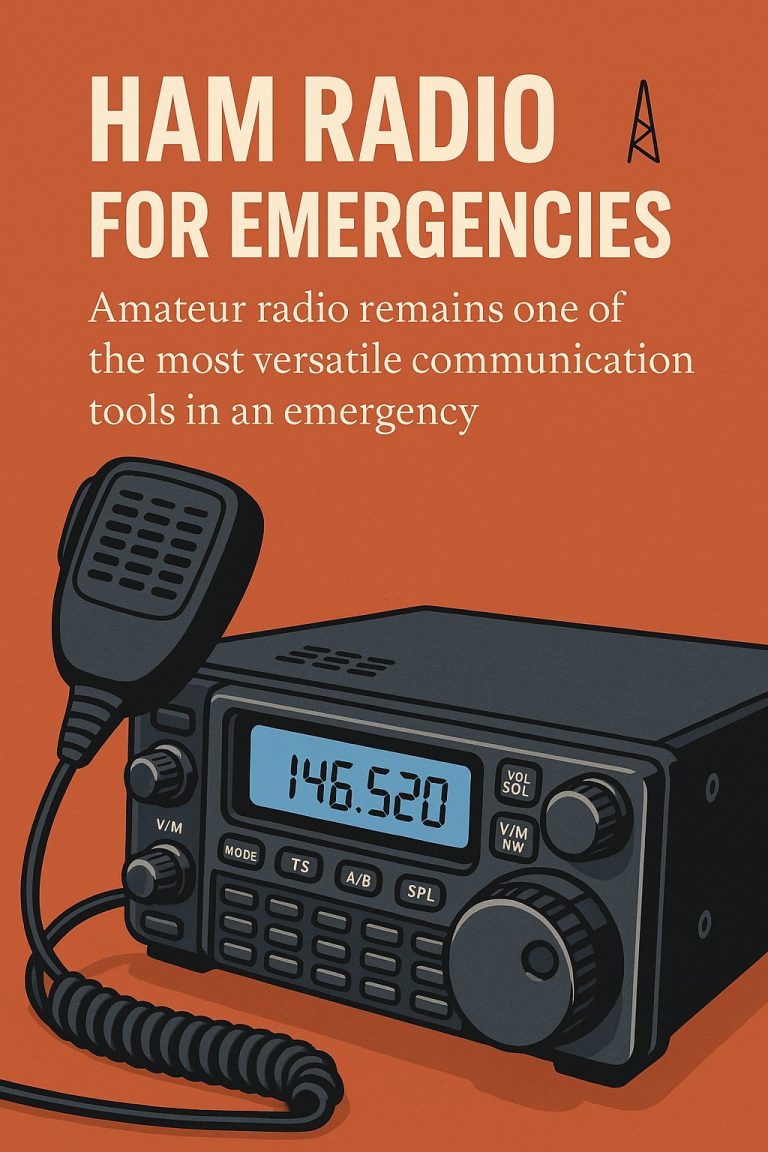When the Grid Falls Silent, Radio Keeps the Community Alive
Introduction
When cell towers go dark, the internet goes down, and emergency services are overwhelmed or offline, most people will be cut off from the outside world. But not you. If you’re a prepper, you know that in a true SHTF scenario, communication is survival—and there’s one tool that has proven itself through every major disaster in the last century: ham radio.
Ham radio, also known as amateur radio, is more than a hobby—it’s a powerful and decentralized method of staying in touch with other prepper groups, coordinating resources, sharing intel, and even calling for help when all else fails.
In this article, we’ll break down how preppers can use ham radio to create their own communication networks and stay connected when it matters most.
📡 Why Ham Radio for Preppers?
- Works off-grid: With a small power source (solar, hand-crank, 12V battery), ham radios can operate anywhere.
- Bypasses infrastructure: No cell towers, no Wi-Fi—just direct radio signals.
- Legal and accessible: In Canada, a Basic Amateur Radio license is relatively easy to obtain.
- Scalable: Use it to communicate locally, across provinces, or globally depending on your gear and conditions.
📶 What You Can Do With Ham Radio
- Coordinate with other prepper groups within your province or across the country.
- Share real-time information: Weather, security threats, evacuation orders, wildfire updates.
- Request help or dispatch aid to other groups.
- Monitor public emergency channels and traffic (RCMP, EMS, aircraft, marine, etc.).
- Build a community: Regular radio “nets” or scheduled check-ins strengthen group cohesion.
🛠️ What You Need to Get Started
1. Licensing (Canada)
To legally operate on amateur bands:
- Take the Basic Qualification Exam administered by Innovation, Science and Economic Development Canada (ISED).
- A pass of 70% or higher gives access to VHF, and UHF frequencies. A pass of 80% or higher gives access to HF frequencies as well as VHF and UHF.
- Resources: Radio Amateurs of Canada
Tip: Study guides, apps, and local radio clubs can help you pass quickly.
2. Equipment Essentials
| Item | Description |
|---|---|
| Handheld Radio (HT) | Portable, great for local use. (e.g., Baofeng UV-5R, Yaesu FT-60R) |
| Mobile Radio | Higher power (20–50W), vehicle- or base-mounted |
| Base Station | Full power (100W+), long-distance HF capability (e.g., ICOM IC-7300) |
| Antenna | The most important part—good range requires a tuned, elevated antenna |
| Power Source | 12V battery, solar setup, generator |
| Programming Cable & Software | CHIRP is a free tool to program radios easily |
📡 Best Frequencies for Prepper Communications
- VHF (2m band – 144-148 MHz)
Ideal for local communications (5–50 km), especially with a repeater. - UHF (70cm band – 430-450 MHz)
More urban-friendly, less range but better in buildings. - HF Bands (3-30 MHz)
Perfect for long-distance (regional to global) comms. Great for serious preppers and rural groups. - Repeaters
Many areas have ham radio repeaters that significantly boost range—if they have backup power.
Note: Have a simplex plan too (direct radio-to-radio) in case repeaters go down.
🗺️ Creating a Prepper Radio Network
Step 1: Build Your Local Net
- Set up regular check-ins with your family, retreat members, and neighbors.
- Use a simple call sign protocol and assign backup channels.
- Practice both voice and Morse code if possible.
Step 2: Connect With Regional Groups
- Join online forums, prepper meetups, or radio clubs to find like-minded hams.
- Schedule weekly “nets” (radio meetings) to build trust and test readiness.
Step 3: Prepare for Black Sky Events
- Keep a written comms plan in your preps: frequencies, call signs, time slots, codes.
- Assign a radio operator for your group and a backup radio.
- Practice operating off-grid using solar-charged batteries and antennas.
🕵️ Security and OPSEC on the Airwaves
Ham radio is not encrypted—anyone with a scanner can listen. That means:
- Never share sensitive info (locations, real names, stockpiles).
- Use code words and phrases prearranged within your group.
- Use short transmissions and rotate frequencies if needed.
- Consider using CB or GMRS for very local, informal chatter.
For higher security, digital modes like Winlink or JS8Call can send emails or messages over radio, but they require a computer and more setup.
🔋 Powering Your Communications
- Solar panels with deep-cycle batteries = long-term independence.
- Store extra 12V batteries, power inverters, and manual chargers.
- Use low-power settings for conservation—especially with HF rigs.
🔧 Practice Makes Perfect
- Test all equipment monthly.
- Participate in real ham events like Field Day or ARES drills.
- Maintain a printed cheat sheet of frequencies, group protocols, and call signs.
🧭 Final Thoughts
When the world goes quiet, ham radio will still be talking. For preppers, it’s not just about reaching out—it’s about linking communities, coordinating survival, and sharing vital intelligence in the face of chaos. Don’t wait for the grid to fail to start using it.
Build your gear, get licensed, and talk to your people. Because when SHTF, silence is deadly—but radio speaks.





